This manual is a comprehensive resource for diagnosing and resolving issues with the Thermo King Tripac system, designed to optimize performance and minimize downtime for drivers and technicians․
Purpose and Importance of the Manual
The Thermo King Tripac Troubleshooting Manual serves as a vital resource for drivers, technicians, and fleet managers to identify and resolve issues efficiently․ Its primary purpose is to provide clear, step-by-step guidance for diagnosing and repairing faults in the Tripac system, ensuring minimal downtime and optimal performance․ By addressing common problems like error codes, refrigerant leaks, and electrical malfunctions, the manual empowers users to maintain their systems effectively․ It is designed to be user-friendly, offering detailed instructions and fault code explanations to help troubleshoot issues quickly․ This manual is essential for prolonging system longevity, reducing operational disruptions, and ensuring compliance with safety and efficiency standards․ Its importance lies in its ability to empower users with the knowledge needed to maintain and repair their Tripac systems independently․
Overview of the Thermo King Tripac System
The Thermo King Tripac system is an advanced auxiliary power unit (APU) designed to provide heating, cooling, and temperature management for trucks and trailers․ It operates independently of the vehicle’s engine, reducing idling time and fuel consumption․ The system consists of key components such as a compressor, condenser, evaporator, and control panel, working together to maintain optimal temperatures․ Its user-friendly interface allows drivers to adjust settings easily․ The Tripac system is known for its efficiency, reliability, and ability to conserve fuel, making it a popular choice in the trucking industry․ Regular maintenance and troubleshooting are crucial to ensure its performance and longevity, which is where the troubleshooting manual plays a pivotal role․

Key Components of the Thermo King Tripac System
The system includes a compressor, condenser, evaporator, and control panel․ The compressor circulates refrigerant, while the condenser and evaporator manage heat exchange․ The control panel provides user interface for system operation and monitoring, ensuring efficient temperature management and diagnostics․
Compressor and Refrigerant System
The compressor is the core of the Thermo King Tripac system, responsible for compressing refrigerant to drive the cooling process․ It is typically driven by the vehicle’s engine or an electric motor․ The refrigerant system includes the compressor, condenser, evaporator, and expansion valve, working together to transfer heat and maintain desired temperatures․ Proper refrigerant levels are critical for system efficiency․ Low refrigerant levels can lead to reduced cooling performance, while overcharging can cause system damage․ Refrigerant leaks are common issues, often requiring professional inspection and repair․ Regular maintenance, such as checking for leaks and ensuring proper refrigerant charge, is essential to prevent system failures and maintain optimal performance․
Condenser and Evaporator Functions
The condenser and evaporator are vital components of the Thermo King Tripac system, playing key roles in heat transfer․ The condenser, typically located at the front of the unit, dissipates heat from the refrigerant to the surrounding air, allowing the refrigerant to condense into a liquid․ The evaporator, positioned inside the refrigerated space, absorbs heat from the cargo area, causing the refrigerant to evaporate into a gas․ Proper airflow through both components is essential for efficient cooling․ Blockages, such as dirt or debris, can impair performance․ Regular cleaning and inspection of these units are recommended to ensure optimal operation and prevent issues like reduced cooling capacity or system overheating․
Control Panel and User Interface
The control panel serves as the central interface for monitoring and controlling the Thermo King Tripac system․ It features a user-friendly design with buttons, a display screen, and status indicators․ The panel allows operators to set temperature preferences, monitor system performance, and view diagnostic information․ Key functions include adjusting cooling modes, enabling defrost cycles, and reviewing error codes․ The display provides real-time data on temperatures, system status, and fault codes, ensuring operators can quickly identify and address issues․ Proper use of the control panel is essential for efficient operation and troubleshooting; Regular checks of button functionality and screen visibility are recommended to ensure accurate system control and monitoring․
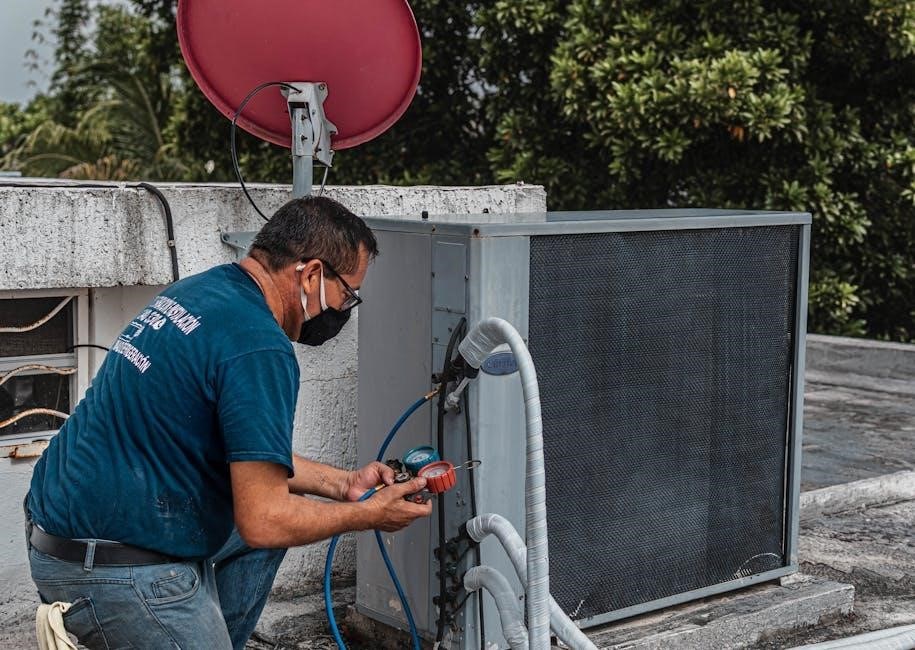
Common Issues and Error Codes
The Thermo King Tripac system often experiences issues like temperature fluctuations, error codes, and system malfunctions․ These are typically caused by electrical faults, refrigerant leaks, or sensor problems․ Diagnosing these issues requires analyzing error codes, performing system checks, and evaluating sensor performance to ensure proper functionality and maintain optimal operation․
Understanding Tripac Fault Codes
The Thermo King Tripac system generates specific fault codes to identify operational issues․ These codes, displayed on the control panel, are alphanumeric and correspond to specific malfunctions, such as temperature sensor errors or compressor faults․ Each code provides insight into the affected component or system, enabling targeted troubleshooting․ For example, “E123” might indicate a refrigerant pressure issue, while “E456” could signal a fan motor malfunction․ Understanding these codes is essential for diagnosing problems accurately․ The manual lists all possible codes, their meanings, and recommended actions․ Familiarity with these codes helps users address issues promptly, minimizing downtime and ensuring efficient system operation․ Always refer to the official manual for accurate interpretations and solutions;
Alarm Codes and Their Meanings
Thermo King Tripac systems use alarm codes to signal specific operational issues․ These codes, displayed on the control panel, are designed to alert users of potential problems․ For instance, a high-discharge pressure alarm may trigger to prevent system damage, while a low-refrigerant-level alarm indicates a possible leak․ Each alarm code corresponds to a particular malfunction, allowing for focused troubleshooting․ Understanding these codes is crucial for maintaining system efficiency and safety․ The manual provides a detailed list of alarm codes, their meanings, and corrective actions․ By referencing these codes, users can quickly identify and address issues, ensuring minimal downtime and optimal performance․ Regular review of alarm codes helps in proactive maintenance and prevents severe system failures․
Common Electrical and Refrigerant Issues
Thermo King Tripac systems often encounter electrical and refrigerant-related problems that can disrupt operation․ Electrical issues may include blown fuses, faulty wiring, or malfunctioning sensors, which can cause unexpected shutdowns or erratic performance․ Refrigerant issues, such as low refrigerant levels or blockages, can lead to reduced cooling capacity or system inefficiency․ Leaks in the refrigerant system are a common culprit, often caused by worn seals or damaged lines․ Ignoring these issues can result in system overload or irreversible damage․ Regular inspection of electrical connections and refrigerant levels is essential to prevent such problems․ Addressing these issues promptly ensures reliable operation and maintains the system’s performance over time․
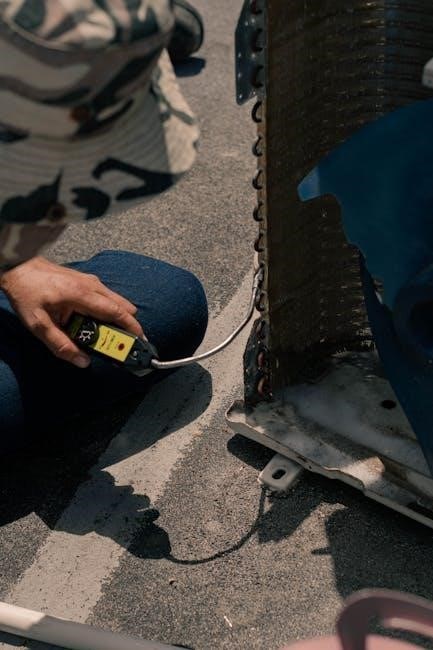
Basic Diagnostic Steps
Basic diagnostic steps involve checking error codes, inspecting electrical connections, and verifying control panel functionality to identify and address issues efficiently․
Checking Error Codes and Alarms
To diagnose issues, start by checking the error codes displayed on the control panel․ Use the manual to interpret each code, as they indicate specific system faults․ Next, inspect the alarm conditions, such as high or low refrigerant pressure, which trigger audible or visual alerts․ Ensure the system is powered on and in operation to accurately capture active issues․ If multiple codes appear, scroll through them using the control panel buttons․ Address each issue sequentially, beginning with critical alarms․ After resolving the problem, reset the system to clear the codes․ For persistent issues, consult the official Thermo King troubleshooting guide or diagnostic tools provided by the manufacturer․ Regularly checking these codes helps prevent system downtime and ensures reliable operation․ Always document the codes for future reference or professional assistance if needed․
Inspecting Electrical Connections
Inspecting electrical connections is a critical step in diagnosing Thermo King Tripac issues․ Begin by locating the system’s electrical components, such as connectors, relays, and fuses․ Visually examine each connection for signs of wear, corrosion, or damage․ Ensure all connectors are securely fastened and not loose․ Use a multimeter to test for continuity or voltage drops if necessary․ Check the wiring harness for any frays or breaks that could disrupt power flow․ Refer to the manual for specific locations and procedures․ Clean or replace any corroded terminals to maintain proper conductivity․ Tighten loose connections to prevent intermittent faults․ Always disconnect power before handling electrical components to avoid safety risks․ Addressing electrical issues early can prevent system malfunctions and ensure reliable operation․ Regular inspections help maintain optimal performance and reduce the risk of unexpected downtime․ Always consult the manual for detailed guidance on electrical diagnostics․
Verifying Control Panel Functionality
Verifying the control panel functionality ensures proper operation of the Thermo King Tripac system․ Start by powering on the system and checking the display for any error messages or abnormal readings․ Test all buttons and switches to confirm they respond correctly․ Ensure the temperature setpoint adjustments work as intended and that the system modes (e․g․, cooling, heating) activate properly․ Check the indicator lights to verify they illuminate as expected․ If the display is unclear or unresponsive, refer to the manual for reset procedures․ Use a multimeter to test voltage at the control panel terminals if functionality is suspect․ Address any issues promptly to maintain system performance․ Regular verification helps identify and resolve control panel malfunctions before they escalate․ Always follow the manual’s guidelines for accurate troubleshooting․ Proper functionality ensures reliable temperature control and system efficiency․
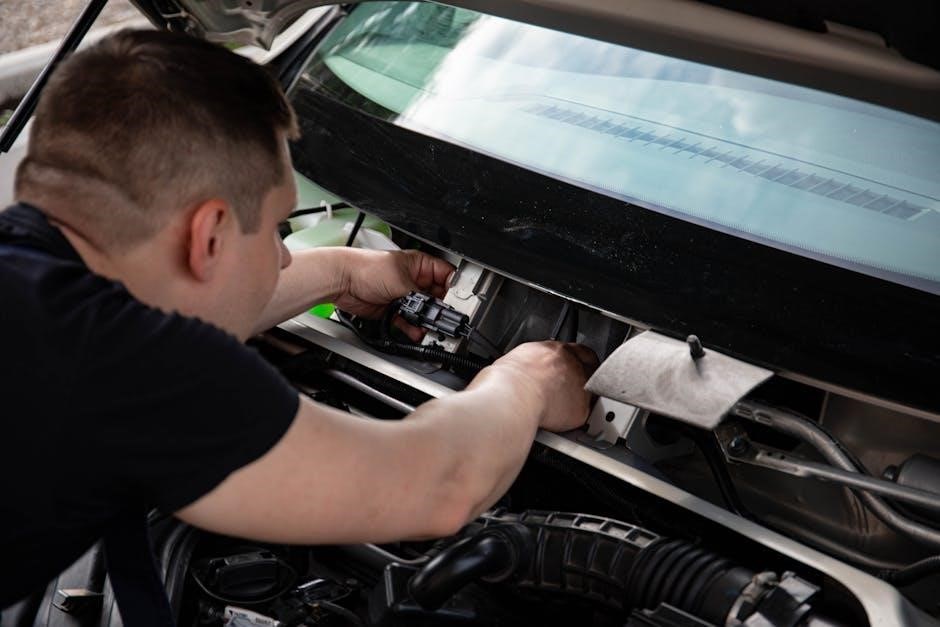
Advanced Troubleshooting Techniques
Advanced techniques involve in-depth diagnostics, specialized tools, and complex system checks to identify and resolve persistent issues․ These methods ensure optimal performance and reliability․ Proper training recommended․
Inspecting the Compressor and Condenser
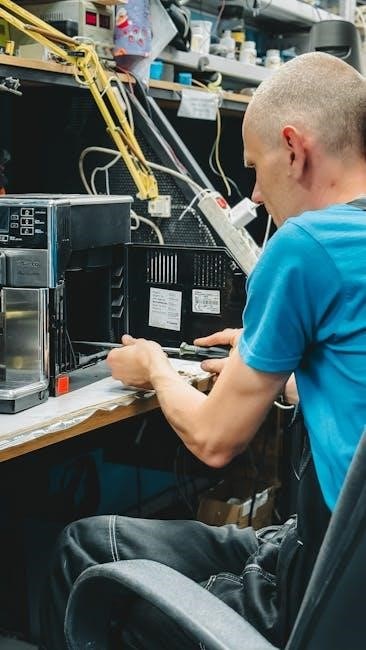
Inspecting the compressor and condenser is crucial for diagnosing issues in the Thermo King Tripac system․ Start by visually examining the compressor for signs of physical damage, leaks, or excessive wear․ Check the mounting bolts for looseness and ensure proper alignment․ For the condenser, inspect the coils for dirt, debris, or bent fins, which can impede airflow and reduce efficiency․ Use a multimeter to verify electrical connections and ensure the compressor and condenser fan motors are functioning correctly․ Measure refrigerant pressure to detect imbalances․ Also, inspect the belts and hoses for cracks or wear․ If issues are found, consult the manual for repair procedures or seek professional assistance to prevent further system damage․
Testing Refrigerant Levels and Flow
Testing refrigerant levels and flow is essential for ensuring the Thermo King Tripac system operates efficiently․ Begin by connecting a set of manifold gauges to the low- and high-pressure ports․ Turn the system on and allow it to run for a few minutes to stabilize․ Record the pressure readings to verify they fall within the manufacturer’s specified range․ Low refrigerant levels can indicate leaks, while high levels may suggest overcharging․ Inspect the sight glass for bubbles, which signal low refrigerant or moisture contamination․ Use an electronic leak detector to identify any leaks in the system․ Additionally, check the flow of refrigerant through the expansion valve and evaporator to ensure proper circulation․ If discrepancies are found, refer to the official manual for detailed repair procedures․
Diagnosing Thermal Management Issues
Diagnosing thermal management issues in the Thermo King Tripac system involves identifying problems related to temperature regulation․ Start by checking the temperature sensors and thermal protectors for proper function․ Ensure the condenser fan and evaporator fan are operating correctly, as faulty fans can disrupt heat exchange․ Verify that the system’s high-pressure switch and low-pressure switch are activating within the specified temperature ranges․ High discharge pressure or abnormal temperature readings may indicate a malfunction in the condenser or evaporator․ Use thermometers to monitor coil temperatures and compare them with expected values․ If the system overheats, inspect for blockages in airflow or refrigerant restrictions․ Addressing these issues promptly prevents system damage and ensures reliable performance․ Always refer to the official manual for specific diagnostic procedures․

Solving Specific Problems
Address specific issues like system malfunctions or error codes by following detailed troubleshooting steps․ Resetting the system, repairing leaks, or replacing faulty components often resolves issues․ Always refer to the manual for guidance․
Resetting the Tripac System
Resetting the Thermo King Tripac system is a straightforward process that can resolve minor glitches or errors․ Begin by turning off the unit and ensuring all electrical connections are stable․ Locate the reset button, typically found on the control panel or near the compressor․ Press and hold the reset button for 10-15 seconds to clear any fault codes or alarms․ After releasing, turn the system back on and monitor its performance․ If issues persist, check for underlying problems such as low refrigerant levels or faulty sensors․ Always refer to the manual for specific reset procedures, as methods may vary between models․ A successful reset should restore normal operation, but consult a technician if problems remain unresolved․
Addressing Refrigerant Leaks
Refrigerant leaks are a common issue in the Thermo King Tripac system, often causing reduced cooling performance․ To address this, first, identify the source of the leak using tools like electronic refrigerant detectors or soapy water applied to hoses and connections․ Turn off the system and allow it to cool before inspecting․ Common leak areas include compressor seals, condenser coils, and refrigerant lines․ Tighten any loose connections and apply sealants to small cracks․ For larger leaks, replace the damaged components․ After repairs, perform a vacuum test to ensure the system is leak-free․ Finally, recharge the refrigerant to the recommended levels and monitor system performance to confirm the issue is resolved․ Always follow safety guidelines when handling refrigerants․

Fixing Control Panel Malfunctions
Control panel malfunctions can disrupt the operation of the Thermo King Tripac system․ Start by restarting the system to resolve temporary glitches․ Check for loose or corroded connections between the control panel and other components; If the display is unresponsive, ensure the power supply is stable․ For faulty buttons or sensors, clean them with a soft cloth or replace them if damaged․ If the issue persists, recalibrate the control panel using the Thermo King diagnostic tool․ Update the system software to the latest version if available․ In severe cases, replace the control panel with a genuine Thermo King part to ensure compatibility and performance․ Always refer to the manual for specific instructions and safety precautions during repairs․
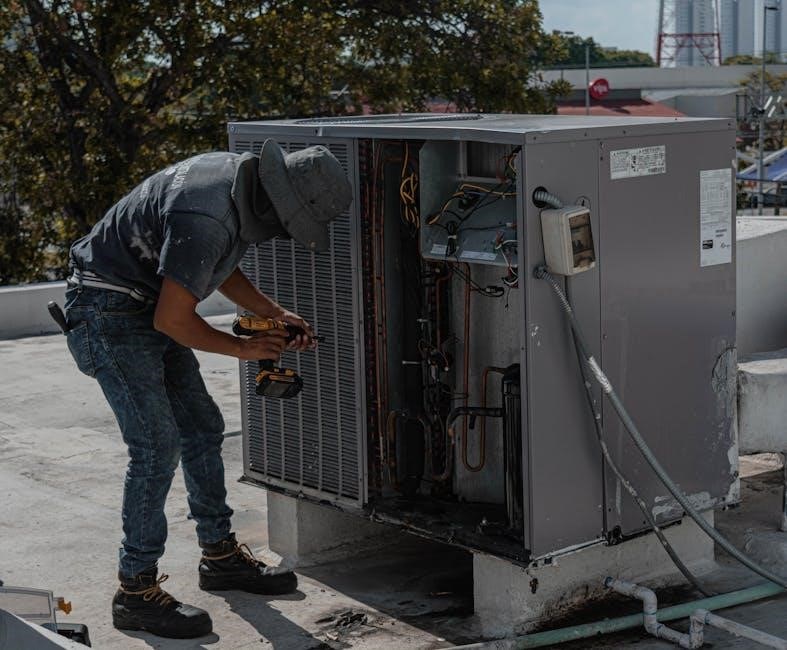
Preventive Maintenance Tips
Regularly inspect and clean filters, check refrigerant levels, and ensure proper electrical connections․ Inspect condenser and evaporator coils for damage or debris․ Schedule annual professional servicing․
Routine Checks for Optimal Performance
Implementing routine checks is vital to ensure the Thermo King Tripac system operates efficiently and reliably․ Begin by inspecting the air filters monthly, cleaning or replacing them as needed to maintain proper airflow․ Check the refrigerant levels regularly to prevent undercharging or overcharging, which can lead to system imbalance․ Inspect electrical connections and wiring for signs of wear, corrosion, or loose contacts, addressing any issues promptly․ Monitor the condenser and evaporator coils for dirt or debris, cleaning them as necessary to maintain heat transfer efficiency․ Additionally, review the control panel logs weekly to identify recurring error codes or alarms․ Perform a visual inspection of hoses and belts for cracks or damage, replacing them before they fail․ Finally, ensure all system components are properly lubricated and aligned to minimize wear and tear․ Regular checks help prevent unexpected breakdowns and optimize performance․
Best Practices for System Longevity
To ensure the Thermo King Tripac system operates efficiently and lasts longer, adopt proven maintenance and operational practices․ Always follow the manufacturer’s guidelines for system usage and maintenance․ Train technicians to handle the system correctly, avoiding practices that could cause unnecessary wear․ Regularly update software and firmware to benefit from performance improvements and bug fixes․ Use genuine Thermo King replacement parts to maintain system integrity and compatibility․ Monitor operating conditions to prevent overheating or overloading, which can strain components․ Store unused components in a dry, climate-controlled environment to prevent corrosion․ Implement a preventive maintenance schedule tailored to the system’s workload and environmental conditions․ By adhering to these best practices, you can significantly extend the lifespan of your Thermo King Tripac system and ensure consistent performance․
Scheduling Regular Servicing
Regular servicing is critical to maintaining the performance and reliability of the Thermo King Tripac system․ Schedule routine maintenance with authorized Thermo King service providers to ensure all components are inspected and serviced according to manufacturer guidelines․ Plan servicing intervals based on usage, environmental conditions, and the system’s operational hours․ Regular maintenance helps prevent unexpected breakdowns, optimizes energy efficiency, and extends the system’s lifespan․ Additionally, periodic inspections can identify potential issues before they escalate, reducing downtime and repair costs․ Always refer to the Thermo King Tripac Troubleshooting Manual for specific servicing recommendations tailored to your system․ By prioritizing regular servicing, you ensure uninterrupted operation and maintain warranty compliance․

Resources for Further Assistance
Consult official Thermo King manuals, online forums, and certified support for additional guidance and troubleshooting expertise, ensuring accurate and reliable solutions for your Tripac system․
Official Thermo King Manuals and Guides
The official Thermo King manuals and guides provide comprehensive instructions for troubleshooting and maintaining the Tripac system․ These resources include detailed diagrams, step-by-step repair procedures, and technical specifications․ They are designed to help technicians and operators identify and resolve issues efficiently․ The manuals cover topics such as system operation, error code explanations, and diagnostic tools․ Additionally, they offer maintenance schedules and best practices to ensure optimal performance․ Thermo King also provides supplementary guides for specific models, like the Tripac EVOLUTION and TriPac Envirotainer, ensuring tailored solutions․ These official documents are essential for anyone working with the Tripac system, as they are developed by the manufacturer and updated regularly to reflect the latest advancements․
Online Forums and Communities
Online forums and communities dedicated to Thermo King systems, such as the Tripac, serve as invaluable resources for troubleshooting and problem-solving․ These platforms allow technicians and operators to share experiences, ask questions, and access collective knowledge․ Many forums feature detailed discussions on specific issues, error codes, and repair techniques․ Users often post real-world solutions and tips for maintaining the Tripac system․ Additionally, these communities provide access to documentation, diagrams, and advice from experienced professionals․ By engaging with these forums, individuals can gain insights into common problems and learn how to address them effectively․ They also offer a space to connect with experts and stay updated on the latest developments in Thermo King technology․
Contacting Thermo King Support
Contacting Thermo King support is a straightforward process for resolving complex issues or obtaining specialized assistance․ Thermo King provides dedicated customer service through various channels, including phone, email, and live chat․ Their official website offers a “Contact Us” section with detailed information and regional support numbers․ For urgent issues, 24/7 assistance is available, ensuring minimal downtime for critical operations․ Additionally, authorized service centers can be located via their website, offering professional diagnoses and repairs․ When reaching out, it’s essential to provide specific details about the Tripac system, such as model and serial numbers, to expedite support․ Thermo King’s expert team can address advanced problems, provide genuine parts, and guide users through complex repairs effectively․

